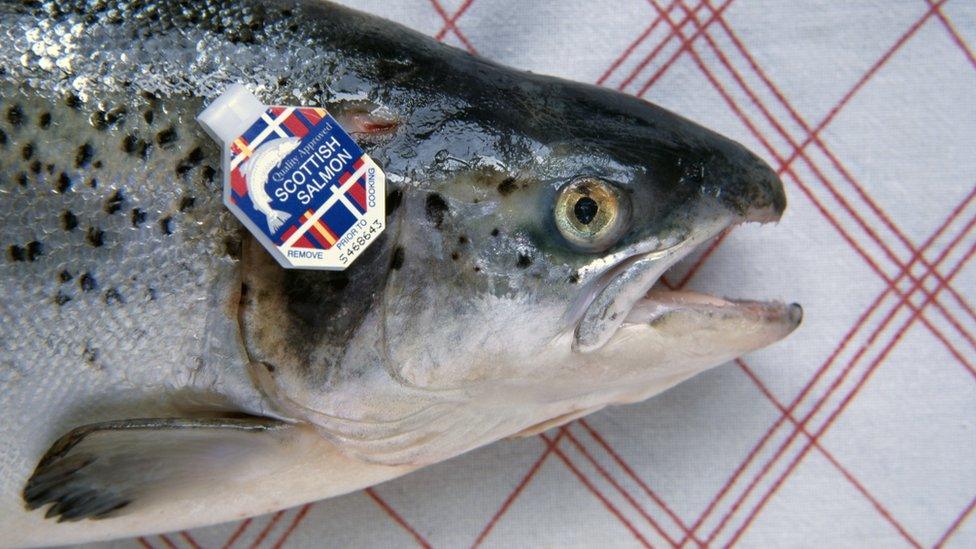Scottish salmon: New sea lice rules to be introduced
- Published

Fish farms will have to report weekly levels of sea lice under new Scottish government proposals.
There has been growing concern about the impact the parasitic lice are having on wild fish stocks.
The industry began to publish sea lice numbers voluntarily last year, but new legislation will be introduced next year to make it compulsory.
Rural Economy Secretary Fergus Ewing also said operators will have to report outbreaks at a much earlier stage.
Sea lice have been blamed for falls in the number of wild and farmed salmon in Scottish waters last year.
The BBC's Panorama programme described last month how severe sea lice infestations on salmon in one loch meant the fish were essentially "eaten alive" by the parasites.
And there were concerns that the large amounts of pesticides being used to combat the lice, as well as faeces and food waste coming from the thousands of salmon in fish farm nets, could be damaging the environment in some of Scotland's lochs.
Greater transparency
But the industry has insisted it is proud of its environmental record, and that sustainable growth of the industry is in everybody's interests.
Speaking in the Scottish Parliament, Mr Ewing said the salmon industry had already recognised that it must become more open and transparent, and had announced its own sea lice reporting plans.
But he said the new legislation would "remove any ambiguity about reporting requirements and will deliver more detailed information about salmon and rainbow trout farms.
"Crucially, it will provide data to enable monitoring of specific farms and issues as they arise, and to allow for further policy change, if needed. To ensure openness and transparency, every sea lice report will be published."

What are sea lice?

Sea lice can weaken the health of salmon and their growth
Small marine parasites that feed on the skin and blood of salmon. They can weaken the health of a fish and its growth.
Can typically float on the tide for 30km, but they have been known to travel 100km.
Can be brought into sea lochs on wild salmon, though they are removed when the fish enter freshwater rivers.
Numbers have increased through the intensity of fish farms, and may also have been boosted by rising sea temperatures.
Treatments include dousing with fresh or warm water, which knocks lice off the salmon. Hydrogen peroxide bleach is another treatment.
Sea lice are not known to have any effect on people when salmon is eaten.

Mr Ewing also said the new rules would lower the current reporting and intervention thresholds - essentially the levels of lice that can be present before action must be taken taken.
And he said the government would explore how to introduce independent checks on fish farms' sea lice counts to ensure the accuracy of the information that is provided.
Mr Ewing also stressed that all salmon producers would also continue to follow the existing code of good practice, which he said was partly responsible for last year having the lowest annual average reported sea lice levels since records started in 2013.
The Scottish Salmon Producers Organisation (SSPO) welcomed the plans - and said it had already shown a lead in ensuring greater transparency.
Chief executive Julie Hesketh-Laird said: "The SSPO has been voluntarily publishing lice data since 2013 and since 2018 reporting has been on a farm by farm basis.
"We are pleased the Scottish government's announcements build on this. We welcome the minister's commitment to public consultation and look forward to engaging fully in it to help ensure that the data collected is used effectively and so the new system can work as well as possible.
"We would expect everyone with an interest in wild as well as farmed salmon and sea lice to work to the same high levels of transparency and ensure data is accurately collected and quickly reported and published. Building trust in the regulatory system is important."